
War and Peace
[Created: 11 Aug. 2014]
[Updated: January 1, 2024 ] |
See also the section on War Art.
Johann von Bloch (Jean de Bloch), Der Krieg (6 vols.) (1899).
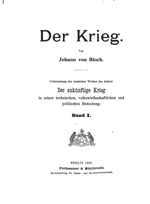 |
Title: Johann von Bloch (Jean de Bloch), Der Krieg. Uebersetzung des russischen werkes des Autors: Der zukünftige krieg in seiner technischen, volkswirtschaftlichen und politischen Bedeutung (Berlin: Puttkammer & Mühlbrecht, 1899). E-Texts:
Comment: Jean de Bloch (1836-1902) was a Polish born banker and railway financier who lived and worked in Russia. The quick Prussian defeat of France in 1870 led him to pursue a scientific study of what a modern war might look like in the near future. This 6 volume work is remarkably prescient in many of his predictions of what actually transpired in WW1 . A 1 vol. abridgement was published in English and a 4 vol. one in French. The Germans got the full 6 vol. treament but ignored it. The graphs and statistical tables about the destructiveness of modern weaponry and his predicted death rates are especially interesting. Guillaumin Collection: War and Peace |
Jean de Bloch, The Future of War (1903).
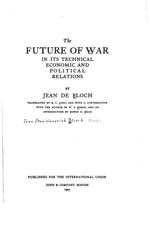 |
Title: Jean de Bloch, The Future of War in its Technical, Economics, and Political Relations. Translated by R.C. Long, and with a Conversations with the Author by W.T. Stead, and an Introduction by Edwin D. Mead (Boston: Published for the International Union, Ginn and Company, 1903). E-Texts: [PDF 8MB] Extracts in HTML: VI. Probable Losses in Future Wars and VII. Militarism and its Nemesis [with data tables] Comment: This is the 1 vol. abridgement of his 6 vol. work originally published in Russian and German in 1899. Guillaumin Collection: War and Peace |
Francis W. Hirst, The Political Economy of War (1915).
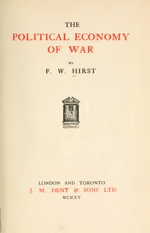 |
Title: Francis W. Hirst, The Political Economy of War (London and Toronto: J.M. Dent & Sons, 1915) E-Texts: [PDF 13MB] Comment: Francis Hirst (1873-1953) was an English classical liberal author and book editor who was the editor of The Economist from 1907 to 1916. He wrote biographies of William Gladstone, Adam Smith, and John Morley and many books on economics. While editor of the Economist he published the first book devoted to the "political economy of war" which drew upon the ideas of Adam Smith and Frédéric Bastiat. Guillaumin Collection: War and Peace |
Yves Guyot, Les Causes et les conséquences de la Guerre (1915).
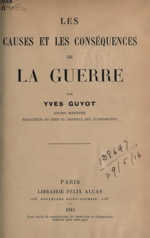 |
Title: Yves Guyot, Les Causes et les conséquences de la Guerre. (Paris: Félix Alcan, 1915). [PDF 23MB] Title: Yves Guyot, The Causes and Consequences of the War (New York: Brentano's 1916). [PDF 8 MB] Comment: Guyot wrote a series of 9 aticles for the Journal des Économistes (of which he was the editor) as the war was unfolding between August 1914 and April 1915 [French version [PDF 16MB]. This was expanded and published as a book which was translated into English. It provides an interesting insight into the minds of the last remaining classical liberals in France before they were marginalised after the war. Guillaumin Collection: French Classical Liberalism and War and Peace |
Poems by Wilred Owen (1921).
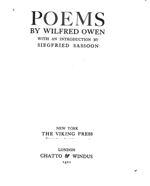 |
Title: Poems by Wilred Owen, with an Introduction by Siegfried Sassoon (New York: The Viking Press; London: Chatto & Windus, 1921). E-Texts: [PDF 436KB] Comment: Wilfred Owen is the best known of the English war poets who fought in WW1. He died on 4 November 1918 one week before the Armistice ended the war. This collection of his war poerty was published by friend Siegfried Sassoon who was also a poet. My favourites in this volume are "Parable of the Old Men and the Young" and "Dulce et Decorum est". His unfinished preface is also very moving. Guillaumin Collection: War and Peace |
Jaroslav Hašek/Josef Lada, The Good Soldier Švejk (1923)
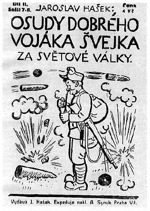 |
Title: A complete collection of the illustrations by Josef Lada for the novel by the Czech author Jaroslav Hašek, The Good Soldier Švejk and his Fortunes in the World War (1923). Comment: The Czech anarchist Hašek served in the Austrian Army during WW1 but deserted to join the Red Army after the Bolshevik Revolution broke out. Not finding that army to his liking either, he deserted again. He created the character Švejk after the war and planned several volumes of his exploits. These consisted in trying to avoid as much miilitary duty as possible, usually by literally carrying out the orders his superiors gave him and thus screwing them up. The illustrations are charming but disguise a very serious argument being made in the book about the nature of authority and how individuals can cope in an impossible situation. [This is a work in progress given the sheer number of illustrations.] Guillaumin Collection: War & Peace |
Ernst Friedrich, War against War! (1924)
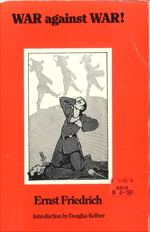 |
Title: Ernst Friedrich, Krieg dem Kriege! Guerre a la Guerre! War against War! Oorlog aan den Oorlog! (Berlin: "Freie Jugend", (1924). Comment: I have not been able to find the orignal book but I do own an edition from 1987 and there are copies of many of the images on the web. I have put together a representative sample of his collection of shocking photographs showing death and destruction in WW1 along with his scathing comments. [Warning: some of these photos as truly shocking. But then, so is modern war.] Guillaumin Collection: War & Peace |
Otto Dix, Der Krieg (1924)
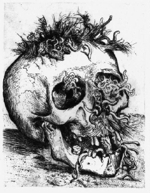 |
Title: Otto Dix, Der Krieg (The War) (Berlin: Otto Felsing, Karl Nierendorf, 1924). Comment: Dix saw service in WW1 and documented his experiences in a collection of drawings which he published in 1924. I have reconstructed the original order of the drawings as they appeared in his 1924 book which were divided into five folios. If they seem a bit extreme they should be seen alongside Ernst Friedrich's collection of photographs in War against War! also published in 1924. Guillaumin Collection: War & Peace |